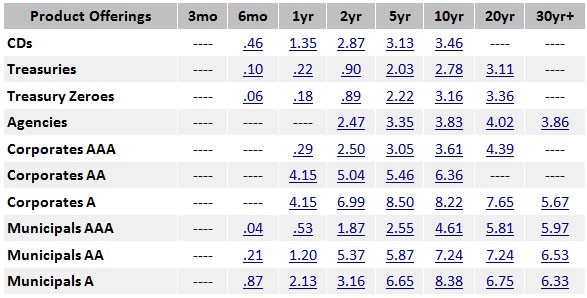Investing In Bonds
Post on: 16 Март, 2015 No Comment

Investing in bonds
Bonds may not be as glamorous as stocks or commodities, but they are a significant component of most investment portfolios. Bonds are traded in huge volumes every day, but their full usefulness is often underappreciated and underestimated.
Why invest in bonds?
Bonds can help diversify your investment portfolio. Interest payments from bonds can act as a hedge against the relative volatility of stocks, real estate, or precious metals. Those interest payments also can provide you with a steady stream of income.
How bonds work
When you buy a bond, you are essentially loaning money to a bond issuer in need of cash to finance a venture or fund a program, such as a corporation or government agency. In return for your investment, you receive interest payments at regular intervals, usually based on a fixed annual rate (coupon rate). You are also paid the bond’s full face amount at its stated maturity date.
You can purchase bonds in denominations as low as $100 (though individual brokers may have a higher minimum purchase). Some are backed by tangible assets, such as mortgage contracts, buildings, or equipment. In many other cases, you simply rely on the issuer’s ability to pay. You can buy or sell bonds in the open market in the same manner as stocks and other securities. Therefore, bonds fluctuate in price, selling at a premium (above) or discount (below) to the face value (par value). Generally, the longer a bond’s duration to maturity, the more volatile its price swings. These factors expose bonds to certain inherent risks.
Bond risk factors
Although many bonds are conservative, lower-risk investments, many others are not, and all carry some risk. Because bonds are traded in the securities markets, there is always the chance that your bonds can lose favor and drop in price due to market risk. Much of this volatility in prices is tied to interest-rate fluctuations. For example, if you pay $1,000 for a 10 percent bond, that same $1,000 might buy you an 11 percent bond the following month, if interest rates rise. Consequently, your old 10 percent bond may be worth only about $900 to current investors.
Since bonds typically pay a fixed rate of interest, they are open to inflation risk. As consumer prices generally rise, the purchasing power of all fixed investments is reduced. Also, there is a chance that the issuer will be unable to make its interest payments or to repay its bonds’ face value at maturity. This is known as credit or financial risk. To help minimize this risk, compare the relative strength of companies or bonds through a ratings service such as Moody’s, Standard & Poor’s, A. M. Best, or Fitch. Finally, bonds also involve reinvestment risk: the risk that when a bond matures, you may not be able to get the same return when you reinvest that money.
Corporate bonds
Bonds issued by private corporations vary in risk from typically super-steady utility bonds to highly volatile, high-interest junk bonds. Also, many corporate bonds are callable, meaning that the debt can be paid off by the issuing company and redeemed on a fixed date. The company pays back your principal along with accrued interest, plus an additional amount for calling the bond before maturity.
Some corporate bonds are convertible and can be exchanged for shares of the company’s stock on a fixed date. You can also purchase zero-coupon bonds, which are issued at a discount to (below) face value. No interest is paid, but at maturity you receive the face value of the bond. For example, you pay $600 for a 5-year, $1,000 zero-coupon bond. At the end of 5 years, you receive $1,000. Corporate bonds have maturity dates ranging from one day to 40 years or more and generally make fixed interest payments every six months.
U.S. government securities
The securities backed by the full faith and credit of the U.S. government carry minimal risk. United States Treasury bills (T-bills) are issued for terms from a few days to 52 weeks. They are sold at a discount and are redeemed for their full face value at maturity. Other Treasury securities include Treasury notes, which have terms from 2 to 10 years, Treasury Inflation Protected Securities (TIPS), which have terms from 5 to 30 years, and Treasury bonds, which have a term of 30 years. Although the interest earned on these securities is subject to federal taxation, it is not subject to state or local taxes.
Various federal agencies also issue bonds. As with any investment, these bonds carry some risk. However, because the U.S. government guarantees timely payment of principal and interest on them, they are considered very safe. Some of these bonds use mortgages as collateral. Most mortgage-backed securities pay monthly interest to bondholders.
Municipal bonds
Municipal bonds (munis) are issued by states, counties, or municipalities, and are generally free from federal taxation (with some exceptions). Some may be completely tax free if you are a resident of the state, county, or municipality of issuance. Though municipal bonds generally offer lower interest payments compared with taxable bonds, their overall return may be higher because of their tax-reduced (or tax-free) status.

Munis come in two types: general obligation (GO) bonds and revenue bonds. GO bonds are backed by the taxing authority of the issuing state or local government. For this reason, they are considered less risky but have a lower coupon rate. Revenue bonds are supported by money raised from the bridge, toll road, or other facility that the bonds were issued to fund. They pay a higher interest rate and are considered riskier. Therefore, research the project being funded to the extent possible before you invest, to make sure that it will generate sufficient income to make payments.
How to begin investing in bonds
Thousands of books, newsletters, and websites can provide you with investment information that can help you evaluate and choose bonds. The major bond-rating services offer concise letter grades regarding the relative strength of a corporation or bond.
However, if you don’t want to go it alone, a brokerage firm or financial advisor can evaluate and recommend choices for you. Keep in mind that brokers or advisors may charge a fee for this service.
You can buy bonds from a broker, from a commercial bank, over the Internet, or (for Treasury securities) directly from the U.S. Treasury. Shares in bond funds can be purchased through a mutual fund or bond trust.
Monitoring your bond portfolio
Of course, you’ll want to keep an eye on your bond portfolio, as you should with all of your investments. Although other factors may affect them, bond prices are often closely tied to interest rates. When rates go up, the market price of your bonds tend to go down; when interest rates fall, your bonds generally rise in value.
Interest rates also tend to affect a bond’s current yield, which measures the coupon rate of your bond in relation to its current price. The current yield rises with a corresponding drop in the price of a bond, and vice versa. In addition, inflation, corporate finances, and government fiscal policy can affect bond prices.
The information in this document is provided by a third party and has been obtained from sources believed to be reliable, but accuracy and completeness cannot be guaranteed by Ameriprise Financial Services, Inc. While the publisher has been diligent in attempting to provide accurate information, the accuracy of the information cannot be guaranteed. Laws and regulations change frequently, and are subject to differing legal interpretations. Accordingly, neither the publisher nor any of its licensees or their distributees shall be liable for any loss or damage caused, or alleged to have been caused, by the use or reliance upon this service.














